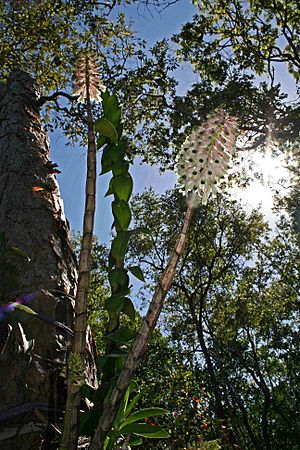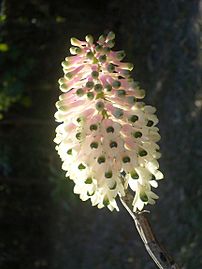Bottlebrush orchid facts for kids
Quick facts for kids Bottlebrush orchid |
|
|---|---|
 |
|
| Scientific classification | |
| Genus: |
Dendrobium
|
| Species: |
smillieae
|
The bottlebrush orchid (scientific name: Dendrobium smillieae) is a special type of orchid. It often grows on other plants (called an epiphyte) or on rocks (called a lithophyte). This orchid has big, spongy stems called pseudobulbs. It also has thin, bright green leaves. These leaves usually fall off after the first year.
The flowers of this orchid grow close together. They look a bit like a bottlebrush. The flowers can be white, cream, or pink. They have a shiny, dark green tip on a part called the labellum. You can find the bottlebrush orchid in the Torres Strait Islands and across Cape York Peninsula in Queensland, Australia. It also grows in New Guinea and parts of eastern Indonesia.
Contents
What Does the Bottlebrush Orchid Look Like?
The bottlebrush orchid is a herb that grows on trees or rocks. It has many stems called pseudobulbs. These stems are ribbed and shaped like a spindle. They can be about 0.3 to 1.0 metre (1.0 to 3.3 feet) long. They are also about 20 to 30 millimetres (0.8 to 1.2 inches) wide.
When the pseudobulbs are young, they have leaves. But as they get older, they lose their leaves. The leaves are bright green and thin. They are often twisted and can be 150 to 200 millimetres (5.9 to 7.9 inches) long. They are also about 30 to 40 millimetres (1.2 to 1.6 inches) wide.
The flowers grow in groups at the end of the pseudobulbs. These groups look like a bottlebrush and are 80 to 150 millimetres (3.1 to 5.9 inches) long. The flowers themselves are white, greenish, cream, or pink. They are shaped like a tube and are 20 to 25 millimetres (0.8 to 1.0 inch) long. The sepals and petals are blunt and do not open very wide. They are 7 to 10 millimetres (0.3 to 0.4 inch) long. The labellum is about 16 millimetres (0.6 inch) long. It has a shiny, dark green tip. These orchids usually flower from August to November.
A special white type of this orchid can be found in the swamps of Sepik in New Guinea.
How Was it Named?
The bottlebrush orchid was first officially described in 1867. A scientist named Ferdinand von Mueller wrote about it. He used a plant sample collected near Rockingham Bay by John Dallachy. The description was published in a book called Fragmenta phytographiae Australiae. The name smillieae was given to honour E.J. Smillie.
Where Does the Bottlebrush Orchid Live?
The bottlebrush orchid is very common and can be found in many places. It grows on trees and sometimes on rocks. You can see it in woodlands, forests, and at the edges of rainforests. It likes trees that get a lot of sunlight. It often grows on trees like Lophostemon suaveolens, which is also called swamp turpentine. These trees have loose, papery bark. The orchid's roots grow under this bark. They form large mats that are well protected.
This orchid is found in New Guinea, including the Bismarck Archipelago. It also lives on the Aru Islands and some of the Torres Strait Islands. In Australia, it grows on the Cape York Peninsula, reaching as far south as Townsville.
How Does it Get Pollinated?
The flowers of the bottlebrush orchid make a sweet liquid called nectar. This nectar attracts birds. The orchid is pollinated by the yellow honeyeater (Stomiopera flava). This bird is also known as the canary honeyeater in Queensland. The yellow honeyeater hovers in front of the flowers to drink the nectar. As it feeds, it helps to spread the orchid's pollen.
Gallery
-
Bottlebrush orchid flower Cooktown



